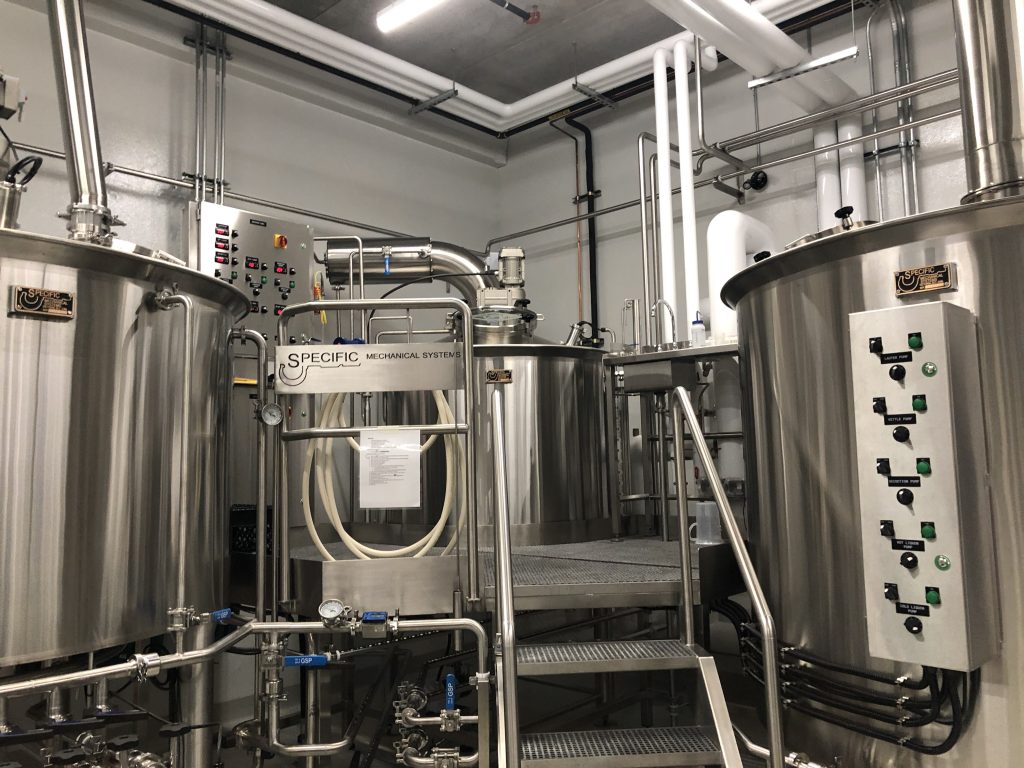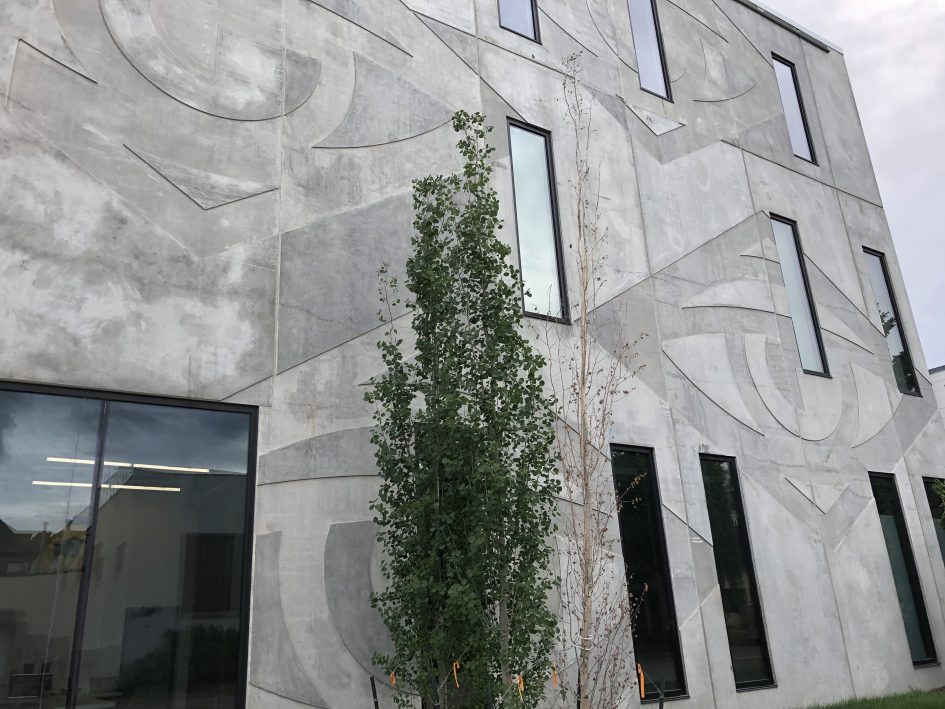With the forthcoming release of Blind Enthusiasm’s second Monolith beer on March 8, I thought it would be a good time to gaze inside this fascinating operation. I did my last CBC column introducing the Monolith to northern Albertans (which you can listen to here), but I felt I barely scratched the surface of what they are doing. So I thought I would flesh things out a bit more here.
Most readers of this website will have some sense of Blind Enthusiasm. Their restaurant and brewery, Biera, has been open for a couple of years now, offering some of the highest quality food Edmonton has seen with well-crafted beer. They call that arm of the company The Market for its location in the Ritchie Market. (Incidentally The Market just released its first beer in its barrel-aged series, Buffalo Meadows.)
For as good as that place is, beer aficionados have been holding their breath in anticipation of the first releases from the Monolith, which is located about six blocks away in a newly build, three-story concrete building with the brewery logo etched into the front wall. (That is the reason it is called The Monolith).
What makes The Monolith so special? It is Canada’s first brewery exclusively producing spontaneous and mixed fermented beer. Confused about those terms? I offer a introduction to the processes in my CBC column, but – in a nutshell – think Lambic. They don’t want to use that name out of respect for the region where Lambic originates (the Senne river valley), but they have adopted the Lambic process and attitude toward beer.
I don’t want to get lost down the rabbit hole of technical details, and there are many, but for now I will say that spontaneous fermentation is about allowing the natural flora in a location inoculate the wort (unfermented beer), which is then fermented in oak barrels for three years. At that time, the beer in each barrel tastes quite different for a variety of reaons, so the brewer must then select and blend quantities of each barrel (or portion of barrels) to produce the desired flavour profile. Some batches will then have fruit added to create additional flavours. This product is then bottled, where it carbonates naturally and is aged for up to a year.
Whew! By this time four to five years have passed from the initial brew day.

Mixed fermentation is a “quick” version of Lambic (sorta). The wort is inoculated with a house blend of yeast and bacteria and then fermented in barrels for only one to two years. This beer is also blended and aged in bottles for 6 to 12 months. To be clear, the two processes create different beer in the end with subtle differences in taste, but many elements of the process are the same.
To the uninitiated this might sound like insanity, or at least folly. But there are hundreds of years of brewing artistry behind it and, more recently, some solid science. The trick (well, at least the first trick) is the ambient temperature when the wort is inoculated. The overnight temperature outside must be between minus-5 and plus-10 Celsius, as that is when the right kind of yeasts and bacteria remain active while other spoiling micro-organisms are dead or dormant. For Edmonton this means a brewing season that includes a few weeks each in the spring and fall. You gotta brew as much as you can when you can and nature tells you what your brewing capacity will be. It is a hard way to run a brewery.
I want to be explicitly clear about something here. This approach to brewing is not the same as making “sour” or “wild” beer (although wild and mixed fermentation are similar in many ways). One key difference is the in-barrel fermentation, but mostly it is a difference in attitude. Beer at the Monolith is meant to be subtle, complex and balanced. “It is not about big flavours that jump out at you,” says Monolith head brewer, Doug Checknita. “It is not just about the acid and more about balance”. Checknita spent many months working at Cantillon, a paragon of spontaneous fermentation (Checknita calls them the “Black Sabbath of sour beer” – a reference that likely only makes sense to metalheads but by which he means all others riff off of their original innovations), and much of what he knows he learned there.
One of the reasons Zeschuk is reluctant to call his beer Lambic is that he is aiming to do something different. “The goal is to mix the best of the old world and the new world to create something new”, he says. Checknita adds, “It is about an old-school ethic with 21st century technology”.
The brewery itself is rather awe-inspiring, despite the dominance of drab concrete throughout. Spontaneous fermentation requires specialized equipment and LOTS of space, so the brewery is fitted with an impressive, custom-made stainless brewhouse and multiple temperature and humidity controlled barrel rooms.
Spontaneous fermentation needs a different wort profile, necessitating specialized equipment including a decoction vessel to “enzyme fix” the wort, just to name one. The aim is to create a wort with a mix of starches and sugars to set up a “buffet for the bugs, which take turns eating their favourite items”, says Zeschuk. (Oh, did I mention they need to use old, stale hops? Yeah.)
The barrel rooms are the dominant aspect of the brewery, taking up room after room. You need a lot of barrels to make this kind of beer. “We need to create a palette of barrels from which to create our blends,” says Zeschuk, channeling his inner Bob Ross (Google it, young ‘uns). The more barrels you have, the more options with which to create unique blends.
As I listened to the details of the process – the tending of barrels, the careful attention to pH and other details, the blending of different barrels to create a specific taste – I am reminded more of wine-making or port-making than beer.

As we sit on the cusp of their second release, Substantially Complete, it is important to view this project as a work in progress. The first release, A Measure of Patience, was intentionally designed to be an introduction to the approch. “It was meant to bring out the subtlety that is possible and be a gentle introduction”, says Checknita. This second release is designed to be more reflective of what they want to do with their mixed fermentation series. “It is blended to Doug’s preferences and is meant to be a staple that we re-create each year”, notes Zeschuk. We tried some of Substantially Complete on-air during my CBC column so if you want to get a sense of what it tastes like, give it a listen (it is right near the end of the segment).
The name of the beer is appropriate, in my mind. The Monolith is up and running and starting to show what it will produce. But just barely. There is still much work to be done and we have only received a tantalizing taste of what is to come – the first spontaneous fermentation beer is still a year or so away.
The brewery is not yet open to the public but Zeschuk does hope to open a tasting room on site “sometime in the next year or so”, when they have enough beer to actually serve people.
Beer drinkers of western Canada. You are put on notice. This is beer you should find a way to try, at least once. You may or may not like it, depending on your personal tastes, but if nothing else you will be a small part of beer history in this part of the world.


Leave a Reply